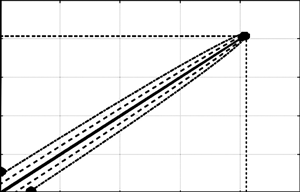Identification of energy-hidden chirp signals of telecommunication systems in conditions of parametric uncertainty
DOI:
https://doi.org/10.3103/S0735272720080026Keywords:
chirp signal, chirp modulation, CM, autocorrelation algorithm, a priori uncertainty, energy-hidden signal, correlation method, radio monitoring, aggregate signal, broadband signal, identificationAbstract
The ambiguity diagram of rectangular chirp RF pulse has been analyzed. The characteristic point of ambiguity diagram was identified. It was proposed to identify the signal on the basis of correlation level at the characteristic point of ellipsoidal ambiguity diagram built in a special coordinate system. The quasi-optimal autocorrelation algorithm with quadrature processing is proposed. This algorithm is resistant to a priori uncertainty of parameters of input energy-hidden signals with unknown waveform and unknown initial phase against the background of Gaussian stationary noise. The tuning parameters of identification scheme and the decision-making rule regarding the availability of chirp signal in the input mixture were determined. The simulation modeling of identification procedure was conducted using the software package Matlab R2016a. The simulation results confirmed the ability of the proposed algorithm to identify the chirp signal in the input mixture at small values of the signal-to-noise ratio.References
- M. Horai, H. Kobayashi, T. G. Nitta, “Chirp signal transform and its properties,” J. Appl. Math., vol. 2014, pp. 1–8, 2014, doi: https://doi.org/10.1155/2014/161989.
- J. G. Proakis, D. K. Manolakis, Digital Signal Processing, 4th ed. London: Pearson, 2006, uri: https://www.amazon.com/Digital-Signal-Processing-John-Proakis/dp/0131873741.
- A. B. Steiskal, “The results of scheme’s design of detecting middle frequency of energy-hidden chirp signals,” Mod. Inf. Technol. Sph. Secur. Def., no. 1, pp. 109–114, 2018, uri: http://sit.nuou.org.ua/article/view/159093.
- S. O. Kovtun, A. B. Steiskal, “Analysis results of signals receiver parameters with linear frequency modulation under the power hidden operating conditions,” Mod. Inf. Technol. Sph. Secur. Def., no. 1, pp. 34–41, 2015, uri: http://sit.nuou.org.ua/article/view/36491.
- O. D. Mrachkovskiy, V. E. Bychkov, A. A. Oleinik, “About degradation of uncertainty function broadband signal with the linear inside impulse frequency modulation,” Visnyk NTUU KPI Seriia - Radiotekhnika Radioaparatobuduvannia, no. 38, pp. 41–45, 2013, uri: http://radap.kpi.ua/radiotechnique/article/view/409.
- L. Zhang, Y. Liu, J. Yu, K. Liu, “Low-complexity spatial parameter estimation for coherently distributed linear chirp source,” IEEE Access, vol. 6, pp. 75843–75854, 2018, doi: https://doi.org/10.1109/ACCESS.2018.2883530.
- A. B. Steiskal, “Synthesis and modulation results of functional unit of frequency deviation measurement of chirp signal with low spectral power density,” Zbirnyk Nauk. Pr. Viiskovoi Chastyny A1906, no. 45, pp. 67–76, 2018.
- M. Joneidi, A. Zaeemzadeh, S. Rezaeifar, M. Abavisani, N. Rahnavard, “LFM signal detection and estimation based on sparse representation,” in 2015 49th Annual Conference on Information Sciences and Systems (CISS), 2015, pp. 1–5, doi: https://doi.org/10.1109/CISS.2015.7086856.
- A. A. Kolchev, A. E. Nedopekin, “Application of model of mixture of probabilistic distributions for definition of the signals of radiophysical probing,” Radioelectron. Commun. Syst., vol. 59, no. 8, pp. 362–368, 2016, doi: https://doi.org/10.3103/S0735272716080057.
- Ieee, IEEE Std 802.15.4a-2007, IEEE Standard for Information Technology-Telecommunications and Information Exchange Between Systems-LANs and MANs-Specific Requirements-Part 15.4: Wireless MAC and PHY Specifications for LR-WPANs-Amendment 1: Add Alternate PHYs, vol. 2007, no. August. Washington: IEEE, 2007, doi: https://doi.org/10.1109/IEEESTD.2007.4299496.

Downloads
Published
2020-08-22
Issue
Section
Research Articles

